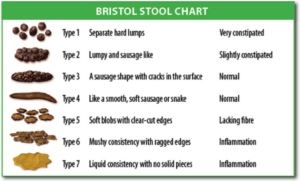 Everyone does it, only a few do it well.
Everyone does it, only a few do it well.
Taking some time to analyze your bowel movements can give you a good indication of what’s going on in your body and specifically your digestive system. The Bristol Stool Chart (pictured above) lists seven types of poo ranging from what constipation looks like to stools that are too loose and indicative of inflammation. Bowel transit times have a range on this chart. Longer bowel transit associated with constipation and faster bowel transit time is associated with diarrhea.
The ideal types of poo are Type 3 and Type 4. In order to achieve these types, ensuring you’re eating the right balance of nutritious foods and digesting these foods is important. Increasing water intake with a pink of sea salt can help with hydration and constipation. Increasing fiber from leafy greens and whole grains in addition to taking digestive enzymes can help slow down bowel transit time to ensure that nutrients are being absorbed by the body.
Another interesting thing to note is how you feel when you’re going number two. If you feel nauseous and your stool floats, it’s an indication that your body isn’t digesting fats as well as it should (we all know fat floats!). Drinking some beet kvass in the morning can help stimulate the gallbladder bile which helps break down fats and will eliminate the nausea. If you’re anxious to have a bowel movement but sitting on the toilet doesn’t do anything, taking some additional magnesium citrate from Pure Encapsulations will relax the body so things can go smoothly. Straining to go to the bathroom and for stools that are hard to pass, drinking more water for lubrication and using a footstool like the Squatty Potty to give you better pooing posture will help ease elimination.
Ready? Set? Let’s go!
